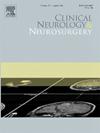门诊诊断性血管造影术患者的入路部位对手术时间和麻醉后护理室 (PACU) 时间的影响:按体重指数分层的倾向分数匹配分析
IF 1.8
4区 医学
Q3 CLINICAL NEUROLOGY
引用次数: 0
摘要
背景和目的体重指数(BMI)是一个可改变的风险因素,已被证明会影响神经介入的结果。据我们所知,体重指数对选择入路部位(经桡动脉入路(TRA)或经股动脉入路(TFA))的影响尚不清楚。我们的研究分析了在门诊环境中接受诊断性脑血管造影术患者的 BMI 分层 TRA 和 TFA 的结果。方法这是对 2018 年 1 月至 2024 年期间在一家机构接受诊断性脑血管造影术患者的前瞻性数据库进行的回顾性分析。根据逻辑回归模型得出的重要协变量,采用 1:1 最佳匹配法计算倾向得分。根据入路部位(TRA和TFA)将患者分为2个队列,并按体重指数分层:(体重不足(BMI<18.5)、正常体重(BMI 18.5-25.0)、超重(BMI 25.0-29.9)和肥胖(BMI>30)。采用线性回归分析和卡方检验比较不同组群的手术时间和麻醉后护理室(PACU)时间。组群的平均年龄为 58 岁,82.4% 为女性。与 TFA 相比,TRA 大幅缩短了体重指数正常和超重亚组患者的手术时间。与 TFA 相比,TRA 缩短了所有 BMI 亚组患者的 PACU 时间。结论 对于在门诊接受择期诊断性血管造影术的某些亚组患者来说,TRA 是替代 TFA 的一种安全可行的方法。某些 BMI 亚组患者的手术时间更短,所有 BMI 亚组患者在 PACU 的恢复时间更短,都证明了这一点。本文章由计算机程序翻译,如有差异,请以英文原文为准。
The impact of access site on procedure time and post-anesthesia care unit (PACU) time in patients undergoing outpatient diagnostic angiograms: A propensity-score matched analysis stratified by body mass index
Background and objectives
Body mass index (BMI) is a modifiable risk factor that has been shown to affect outcomes in neurointervention. The impact of BMI on choice of access site (transradial access (TRA) or transfemoral access (TFA), remains undescribed to our knowledge. Our study analyzes outcomes of TRA and TFA stratified by BMI in patients undergoing diagnostic cerebral angiograms in an outpatient setting.
Methods
This was a retrospective analysis of a prospectively maintained database of patients who underwent diagnostic cerebral angiograms at a single institution from January 2018–2024. Propensity scores were calculated using a 1:1 optimal match method based on significant covariates derived from a logistic regression model. Patients were grouped into 2 cohorts based on access site (TRA and TFA) and stratified into BMI subgroups: (underweight (BMI <18.5), normal weight (BMI 18.5–25.0), overweight (BMI 25.0–29.9) and obese (BMI >30). Linear regression analysis and chi-square test was used to compare procedure time and post-anesthesia care unit (PACU) time across cohorts.
Results
678 patients were grouped into 2 cohorts (TRA and TFA) of 339 each. The average age of the cohort was 58 years, and 82.4 % was female. TRA significantly shortened procedure times in patients across normal and overweight subgroups of BMI compared to TFA. TRA shortened PACU times across all BMI subgroups compared to TFA. There was no significant association between access site complications or post-operative complications for TRA or TRF across BMI subgroups.
Conclusion
TRA is a safe and feasible alternative to TFA in certain subgroups of patients undergoing elective diagnostic angiogram in the outpatient setting. This is evidenced by shorter procedure time across certain BMI subgroups and shorter recovery time in the PACU across all BMI subgroups.
求助全文
通过发布文献求助,成功后即可免费获取论文全文。
去求助
来源期刊

Clinical Neurology and Neurosurgery
医学-临床神经学
CiteScore
3.70
自引率
5.30%
发文量
358
审稿时长
46 days
期刊介绍:
Clinical Neurology and Neurosurgery is devoted to publishing papers and reports on the clinical aspects of neurology and neurosurgery. It is an international forum for papers of high scientific standard that are of interest to Neurologists and Neurosurgeons world-wide.
 求助内容:
求助内容: 应助结果提醒方式:
应助结果提醒方式:


